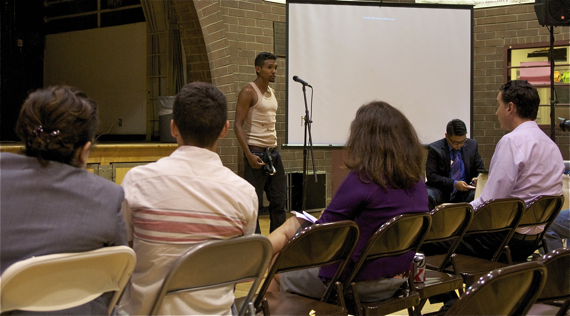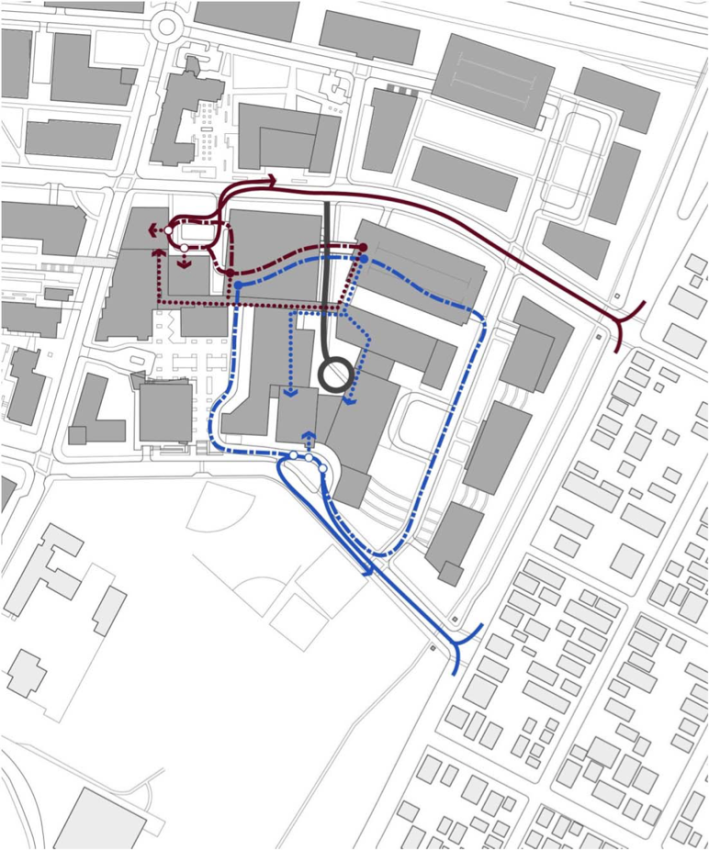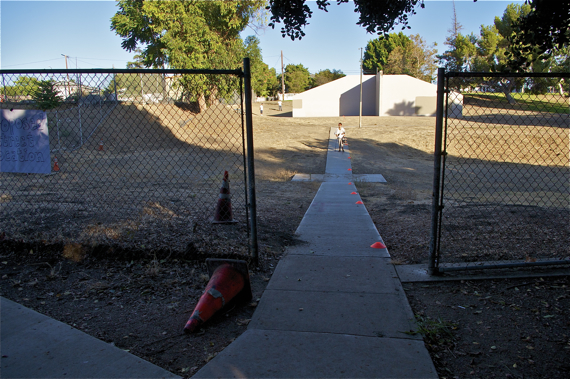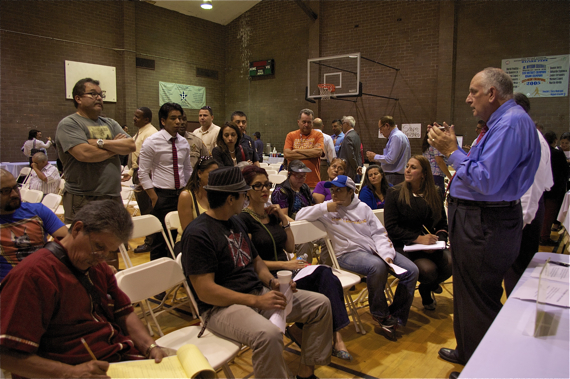USC’s Planned Expansion in Boyle Heights: When Planning Objectives and Community Perceptions Collide
2:36 PM PDT on August 14, 2013

Taking a deep breath as he looked out over the crowd that had gathered in the gymnasium of Hazard Park to discuss USC's planned expansion on its Health Sciences Campus, the lanky and earnest youth with the air filtration mask dangling from his belt made an appeal to the hearts of the USC representatives.
"There's a lot of diamonds out here," 23-year old Gonzalo Ceja said of the youth in the Boyle Heights neighborhoods surrounding the area.
"All they need is polishing."
By "polishing," he was referring to his desire to see a new track and improved athletic and recreational facilities at the park, situated next door to the County-USC medical complex. He had grown up and still lived within spitting distance of the park, and wanted youth like himself -- a top-ranked track star at East L.A. Community College with Olympic aspirations -- to be able to stretch their legs, their lungs, and their horizons.
Decades younger than most of the hearing's attendees, he seemed to be symbolic of the future that many said they were seeking to protect.
While they had responded enthusiastically to a number of the commenters speaking in opposition to USC's plans or demanding a more meaningful partnership, Ceja's plea seemed to have struck a real chord with attendees. They cheered him loudly and some approached him afterwards to encourage him to continue to follow his dreams.
It dawned on me that if anyone were to have just dropped into the meeting at that moment -- or at any other time during the workshop and public comment period, really -- they would have had been very confused as to what the purpose of the event was.

To USC, this was a (largely) straightforward public hearing to inform the community about a set of changes that would be coming to the area.
Planned improvements included the construction of a new clinic building, student housing, and a hotel and the extension of Norfolk St. to Soto St. The buildings would be built on land USC already owned while the new roadway would be built on land the city had long-ago designated for the roadway and that was not technically a part of Hazard Park. In exchange, residents would get new handball courts and some improvements in the form of an exercise circuit.
Anticipating some pushback from the community, particularly on the street construction, Craig Keys (Associate Senior Vice President, Civic Engagement at USC) walked me out the back end of the gym to show me the cones indicating where the extension of Norfolk street would go.
He told me I would hear a lot of things said that night, but that it was important to understand that the Norfolk extension would not fall on park land. Yes, there was a handball court straddling some of the land that would need to be removed and rebuilt, but it had been put on the city land by mistake -- USC was not taking anything from the community.

To community members, however, these technical truths were of little consequence. They cared more about the symbolism of the expansion.
That didn't mean that there weren't real concerns about the project.
Residents Pepe and Cristina, for example, feared that the construction of the dormitory would negatively impact their neighborhood by increasing traffic and making parking more difficult. Medical students were already avoiding paying high fees at the medical complex by parking on the area's side streets. More students on the campus would likely only exacerbate this problem.
They and others were angered by the suggestion from a project consultant that a potential solution might entail putting parking restrictions on residential streets. Why should they have to pay for permits to park near their own residences because of some cheap USC med students? It didn't seem fair to them.
Nor did the potential for increased traffic and air pollution in an area already hemmed in by two freeways, two very busy thoroughfares, and well-used freight train tracks.
Gentrification concerns were also high on the list.

Not only did people believe that locals would be shut out of jobs and opportunities to compete for commercial space in the proposed hotel, but they feared the full-time presence of med students and hotel patrons would mean negatively impact the character of the community.
Especially if med students, emboldened by USC's expansion but wanting to avoid student housing, began moving into the surrounding residential areas. Residents were not looking forward to the potential of raised rents or the intensification of profiling of youth seen around the University Park Campus in South L.A.
The real issue, however, lay in Cristina's suggestion that, "Honestly, [USC] do[es]n't understand people's ties to this park."
Many consider Hazard Park to be sacred ground.
In the 1960s, activists and environmentalists spent seven years successfully fighting the city's plans to construct a veterans hospital there. In 1968, Lincoln Heights teacher Sal Castro, led the Eastside "blowouts" -- walkout protests of schools that activists claimed set Mexican-Americans up to fail -- to Hazard Park. Castro and the blowouts are thought to have played an important role in both the history of the area and in launching the larger Chicano rights movement.
While the facilities, wetlands area and de facto bird sanctuary, and the park itself might appear somewhat degraded from the lack of investment over the years, the spirit of the place and what it represents to the community remains very, very present for many.
USC's attempt to position themselves as good community partners that would respect and help preserve this heritage were therefore not ringing true to anyone.
"If it was the city's land, why didn't they build that extension [of Norfolk]?" asked someone who felt USC was blaming the city instead of owning up to their own land-grabbing aspirations.
"[USC has] a history of broken promises... as far as resources and jobs," said another man, claiming USC had done little outreach to at-risk youth, reneged on promises of youth apprenticeships for wetlands preservation, and made little real investment in the community.
"If you've been here for 100 years," said one man, referencing USC's claim to have a history in the area, too, "why has it taken so long for you to recognize us as a community?"
Others questioned whether USC knew what it meant to "listen" to a community, citing the drawn-out process behind the specific plan for the South L.A. campus and their perception that the community got steamrolled. They feared giving in on the Norfolk extension would inevitably lead to more park or residential space being taken later.
"They're like junkies," said one man angrily, "and they got the money to pay for their habit!"
I looked down at the glossy packet detailing USC's investments in communities around Los Angeles that USC representatives had handed me on the way in to the meeting and was inclined to think things were really not going well for USC at this point.
In truth, it was hard to know how things were going.
A number of the most vociferous speakers last Thursday night had also been present at the same workshop held the previous Saturday. And, they were repeating a lot of the same concerns that they had voiced then.
So, while it seemed like there was a critical mass of opposition, at this stage of the outreach process, at least, it isn't completely clear where the wider community stands on the project.
Only time and greater outreach will help clarify the community's position. Unless, as longtime activist Vic Choudry claims, people (referring to the residents of Ramona Gardens) so loathe USC that they won't even engage them for fear of participating in their own "blackmailing."
Whatever the case, making an effort to be more innovative in their outreach might be one step USC could take.
According to Pepe, right now it feels like "your neighbor is moving their fence into your yard and then inviting you over to barbeque" in their new space.
"Who would be OK with that?"
Sahra is Communities Editor for Streetsblog L.A., covering the intersection of mobility with race, class, history, representation, policing, housing, health, culture, community, and access to the public space in Boyle Heights and South Central Los Angeles.
Read More:
Stay in touch
Sign up for our free newsletter
More from Streetsblog Los Angeles
Metro Committee Approves 710 Freeway Plan with Reduced Widening and “No Known Displacements”
Metro's new 710 Freeway plan is definitely multimodal, definitely adds new freeway lanes, and probably won't demolish any homes or businesses
Automated Enforcement Coming Soon to a Bus Lane Near You
Metro is already installing on-bus cameras. Soon comes testing, outreach, then warning tickets. Wilshire/5th/6th and La Brea will be the first bus routes in the bus lane enforcement program.




